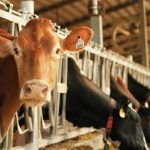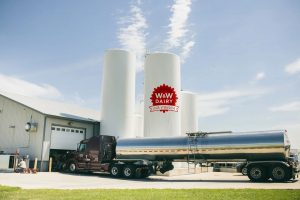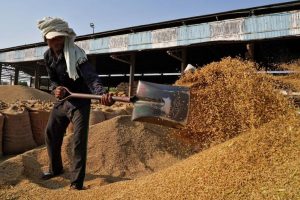
There are insuperable market, phytosanitary and political obstacles — and it could get worse.
Donald Trump is an equal-opportunity mercantilist. When it comes to the European Union’s €198 billion trade surplus with the United States, he’ll claw at any sector he can. Brandishing 25 percent tariffs on EU steel and aluminum, the U.S. president has demanded that the bloc buy more American cars, fossil fuels, weapons, pharmaceuticals — and food.
“They don’t take our farm products, they take almost nothing and we take everything from them … tremendous amounts of food and farm products,” Trump complained to journalists in Florida earlier this month, decrying his country’s €18 billion deficit in agri-food trade with Europe.
Taking more of the first four is feasible. The Commission can lower its 10 percent duty on imported automobiles, while EU countries can purchase less oil from Kazakhstan, fewer missiles from South Korea, and smaller drug batches from Switzerland. These demands would hurt local industry, but they are doable if Brussels wants to appease the irascible ultranationalist.
The fifth is not. A range of culinary, phytosanitary and political obstacles bar the way to Europe’s importing most American staples — from Texan beef and Kentucky chicken to Wisconsin milk and Kansas wheat. Then there’s the fact the new EU commissioners for agriculture and animal welfare, Christophe Hansen and Olivér Várhelyi, want to tightly regulate agri-food imports.
It may be a bitter pill for the president to swallow. But not even his “Art of the Deal” can vanquish Europe’s Art of the Meal.
The invisible hand picks European food
Contrary to what Trump says, the imbalance in agri-food trade isn’t due to unfair customs duties. U.S. and EU rates are similarly low for most products: zero for hard liquor, a few percent for wine and cereals, and 5 percent to 10 percent for fruits, vegetables, cured meats, confectionery, canned food and processed goods.
The exceptions are EU dairy and pork (often upward of 20 percent), yet these aren’t areas where American rivals have much of a chance anyway, given that the EU runs a massive surplus in both categories (Germany and Spain are top exporters). Moreover, the U.S. is protective too — for example, on beef — and accepted higher EU dairy duties in the 1988 Uruguay round of GATT negotiations.
Why? Because it extracted a promise that the EU wouldn’t subsidize oilseed production. Why would that matter to the Americans? Because that’s what they’re best at cultivating. Farms in the U.S. are on average 10 times bigger than in the EU and are able to churn out raw materials: hunks of meat, blocks of cheese and silos full of cereals.
However, apart from the odd Californian wine, the U.S. doesn’t have many specialty products to vaunt. Europe is the opposite: A mosaic of small, regionally diverse farms, its producers are uncompetitive in most commodities, but possess an advantage in traditional foods. For example, the continent has five times more “geographical indication” trademarks than the U.S., allowing its farmers to transform simple crops into premium goods.
It’s bad agribusiness but great gastronomy, which is the second reason Americans spend more on EU farm goods than vice versa. While Americans happily gobble and slurp European GIs, Europeans typically find U.S. foods too fatty, salty, sugary or alcoholic for their palates.
“If you look at the product composition, it’s very different,” said John Clarke, until recently the EU’s top agricultural trade negotiator. “The EU exports mostly high-value products: wine, spirits, charcuterie, olive oil, cheese. The U.S. exports low-value commodities: soya, maize, almonds … the fact [these have] a lower unit value is a fact of life.”
During Trump’s first term, a bad harvest in Brazil and Argentina at least gave Commission President Jean-Claude Juncker an opportunity to offer Washington an apparent concession: The EU would buy more American soybeans. Trump gleefully celebrated what was in fact a financial necessity for European farmers, who need soy for animal feed.
This time that won’t work, though. Brazilian grain harvests are near record levels, while Ukraine is investing heavily in oilseeds. The Commission is rolling out a protein strategy that encourages supply diversification and more domestic production. And Europeans are eating less red meat, dragging soybean demand down.
Phytosanitary paranoia
If Trump wants Europeans to eat more American food, he’ll have to convince them to swallow something even tougher: U.S. food safety standards.
Europeans might buy American software, movies and weapons, but they aren’t keen on U.S. beef pumped with hormones, chlorine-washed chicken or genetically modified corn. The main reason? Brussels’ precautionary principle — a regulatory approach that requires proof a product is safe before it can be sold. The U.S., by contrast, operates on a risk-based system, where anything not proven harmful is fair game.
That divergence has created a trade minefield. American beef exports are capped at 35,000 metric tons annually under a special quota, thanks to an EU-wide ban on hormone-treated meat. U.S. poultry is largely locked out because of pathogen reduction treatments — a fancy way of saying Americans rinse their chicken in antimicrobial washes the EU deems unacceptable. Genetically modified crops, a staple of U.S. agribusiness, also face strict EU restrictions, requiring lengthy approvals and labeling rules that spook European consumers.
Pesticides are another flash point. Today, over 70 different pesticides banned in the EU as toxic to human health and the environment remain widespread in U.S. grain and fruit farming. That includes chlorpyrifos, an insecticide linked to brain damage in children, and paraquat, a weedkiller associated with a higher long-term risk of Parkinson’s disease. As a result, Brussels imposes residue limits that frequently force U.S. growers to create separate, EU-compliant supply chains.
While Trump may rage about tariffs and trade imbalances, it’s Brussels’ food safety regulations — not import duties — that are keeping much American food off European plates. And with the EU mulling even stricter crackdowns on imports that don’t conform to its standards, expect the transatlantic trade menu to get even leaner.
Don’t anger the farmers
Trump may not be aware, but European capitals also witnessed furious farmer protests last year. Fear of foreign competition was one of the main triggers, with unions bitterly criticizing imports from Ukraine and South America’s Mercosur bloc for their looser production standards, laxer agrochemical use and cheaper agricultural land.
Poland, Hungary and Slovakia have still not lifted their illegal blockades on Ukrainian grain, and the Commission is in no position to force them to do so. In fact, Brussels has responded by making fair pricing for farmers the lodestar of its upcoming agri-food policy. The EU even wants to apply “mirror clauses” to imports to align rules on animal welfare and pesticides, according to a leaked draft of a long-term policy vision due out this week.
A surge in U.S. imports would likely prompt the same attacks. These could be politically decisive ahead of stormy presidential races this year in Poland and Romania, two European breadbaskets, as well as major elections in France, Italy and Spain in the next two years.
So is there no solution to Trump’s hunger for agri-trade parity? It seems not, unless the president decides to massively expand the U.S. military’s presence in the EU, bringing tens of thousands more peanut butter-loving troops to defend the continent’s security. It’s a crazy idea of course. Then again …
Giovanna Coi contributed reporting.
You can now read the most important #news on #eDairyNews #Whatsapp channels!!!
🇺🇸 eDairy News INGLÊS: https://whatsapp.com/channel/0029VaKsjzGDTkJyIN6hcP1K
























